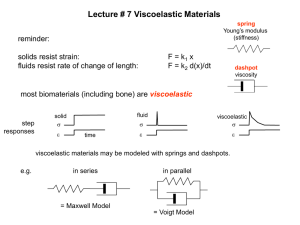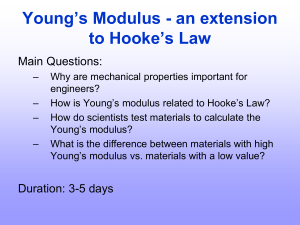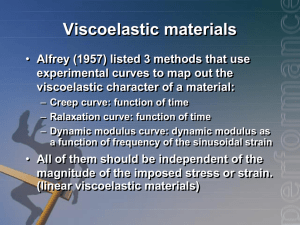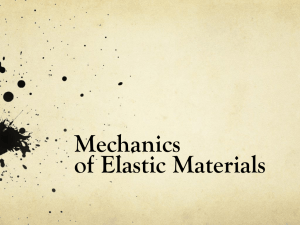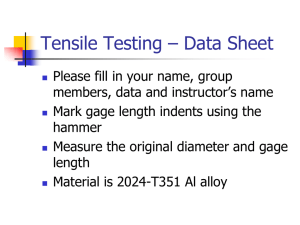G - Loy Research Group
advertisement
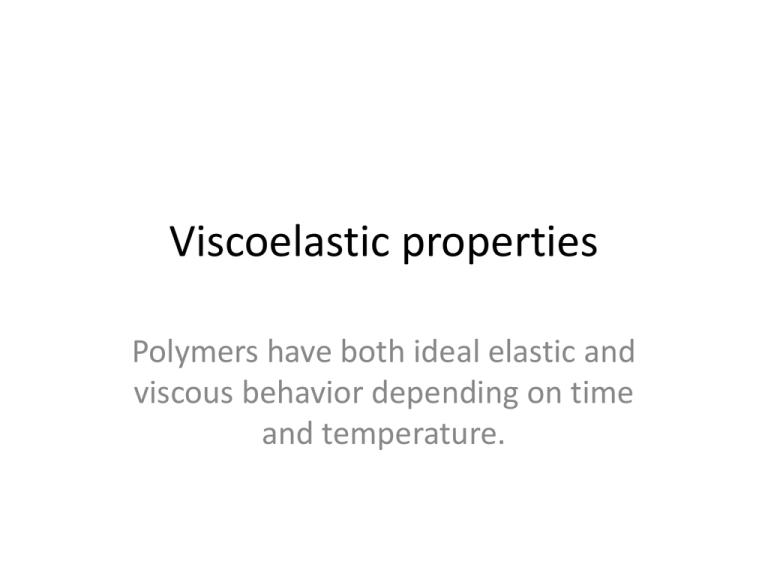
Viscoelastic properties Polymers have both ideal elastic and viscous behavior depending on time and temperature. Ideal (elastic) Solid E Hooks Law response is independent of time and the deformation is dependent on the spring constant. Ideal Solid E Ideal Liquid = viscosity de/dt = strain rate de dt The viscous response is generally time- and rate-dependent. Ideal Liquid The behaviour of linear elastic were given by Hooke’s law: • Ee • or dt The behaviour of linear viscous were given by Newton’s Law: d de dt E de dt E= Elastic modulus = Stress e= strain de/dt = strain rate d/dt = stress rate = viscosity ** This equation only applicable at low strain Viscoelastic behavior • Behaviour of most polymer is in between behaviour of elastic and viscous materials. 1. At low temperature & high strain rate, 2. At high temperature & low strain rate, 3. Polymer demonstrate elastic behaviour, Polymer demonstrate viscous behaviour At intermediate temperatures & rate of strain Polymer demonstrate visco-elastic behaviour Polymer is called visco- elastic because: • • Showing both behaviour elastic & viscous behaviour • Instantaneously elastic strain followed by viscous time dependent strain Load released elastic Load added elastic viscous viscous Maxwell Model Kelvin Voigt Model Burger Model Static Modulus of Amorphous PS Glassy Leathery Rubbery Viscous Polystyrene Stress applied at x and removed at y Dynamic Mechanical Analysis Spring Model g = g0⋅sin (ω⋅t) g0 maximum strain w = angular velocity Since stress, t, is t Gg t Gg0sin(wt) And t and g are in phase Dashpot Model t dashpot g g o w cos( w t ) Whenever the strain in a dashpot is at its maximum, the rate of change of the strain is zero ( g = 0). Whenever the strain changes from positive values to negative ones and then passes through zero, the rate of strain change is highest and this leads to the maximum resulting stress. Kelvin-Voigt Model Dynamic (Oscillatory) Testing In the general case when the sample is deformed sinusoidally, as a response the stress will also oscillate sinusoidally at the same frequency, but in general will be shifted by a phase angle d with respect to the strain wave. The phase angle will depend on the nature of the material (viscous, elastic or viscoelastic) Input g g o sin( w t ) Response t t o sin( w t d ) where 0°<d<90° t stress g strain viscosity G modulus 3.29 Dynamic (Oscillatory) Testing By using trigonometry: t t o sin( w t d ) t o sin( w t ) t o cos( w t ) (3-1) In-phase component of the Out-of-phase component stress, representing solid- of the stress, representing like behavior liquid-like behavior Let’s define: where: t o G g o and t o G g o G ( w ) in phase stress maximum G ( w ) strain t o go out of phase stress maximum strain , Elastic t o go or Storage Modulus , Viscous or Loss Modulus 3.30 Physical Meaning of G’, G” Equation (3-1) becomes: t g o G ( w ) sin( w t ) G " ( w ) cos( w t ) We can also define the loss tangent: tan d G G For solid-like response: t spring G g G g o sin( w t ) G G , G 0, tan d 0, d 0 For liquid-like response: t dashpot g g o w cos( w t ) G 0 , G w , tan d , d 9 0 G’ storage modulus G’’ loss modulus Real Visco-Elastic Samples Typical Oscillatory Data Rubber G’ G’ storage modulus log G G’’ G’’ log w Rubbers – Viscoelastic solid response: G’ > G” over the whole range of frequencies loss modulus Typical Oscillatory Data Melt or solution G0 Less liquid like G’ storage modulus log G G’’ loss modulus G’’ More liquid like G’ log w Polymeric liquids (solutions or melts) Viscoelastic liquid response: G” > G’ at low frequencies Response becomes solid-like at high frequencies G’ shows a plateau modulus and decreases with w-2 in the limit of low frequency (terminal region) G” decreases with w-1 in the limit of low frequency Blend Epoxy Nylon-6 as a function of humidity E’ storage modulus Polylactic acid E’’ loss modulus Tg 87 °C Tg -123 °C (-190 F) Tm 135 °C (275 F) G’ storage modulus Polyurethane foam (Tg 160 C) G’’ loss modulus G’ G’’ storage modulus loss modulus These data show the difference between the behaviour of un-aged and aged samples of rubber, and were collected in shear mode on the DMTA at 1 Hz. The aged sample has a lower modulus than the un-aged, and is weaker. The loss peak is also much smaller for the aged sample. Tan d of paint as it dries Epoxy and epoxy with clay filler Dynamic test of a Voigt solid Benefits of Dynamic Testing



